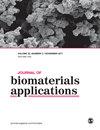PURION® processed human amnion chorion membrane allografts retain material and biological properties supportive of soft tissue repair
IF 2.3
4区 医学
Q3 ENGINEERING, BIOMEDICAL
引用次数: 0
Abstract
The reparative properties of amniotic membrane allografts are well-suited for a broad spectrum of specialties. Further enhancement of their utility can be achieved by designing to the needs of each application through the development of novel processing techniques and tissue configurations. As such, this study evaluated the material characteristics and biological properties of two PURIONPURION® 加工的人羊膜绒毛膜同种异体移植物保留了有助于软组织修复的材料和生物特性
羊膜异体移植的修复特性非常适合广泛的专业领域。通过开发新的加工技术和组织结构来满足每种应用的需求,可以进一步提高其实用性。因此,本研究评估了两种 PURION® 加工羊膜产品(冻干人羊膜、中间层和绒毛膜 (LHACM) 和脱水人羊膜、绒毛膜 (DHACM))的材料特性和生物属性。LHACM 较厚,因此其处理特性非常适合用于深层软组织缺损;而 DHACM 更类似于薄膜状覆盖物,可用于浅层缺损或手术覆盖。通过一系列与愈合级联相关的体外和体内研究,对 LHACM 和 DHACM 的异同进行了表征。通过组织学染色进行成分分析,并通过平衡透析评估屏障膜的特性。体外细胞反应是通过细胞增殖、迁移和新陈代谢实验来评估成纤维细胞和内皮细胞的反应。在无胸腺裸鼠皮下植入模型中对体内细胞反应进行了评估。结果表明,PURION® 工艺保留了两种产品的原生膜结构、无活力细胞以及分布在各层的胶原蛋白。虽然 LHACM 比 DHACM 厚,但两者保留了类似的生长因子、细胞因子、趋化因子和蛋白酶成分,因此可引起类似的体外和体内细胞反应。在培养过程中,两种处理方法都可作为强效的有丝分裂原、趋化因子和刺激剂,从而在小鼠模型中促进细胞浸润、新胶原沉积和血管生成。经 PURION® 处理的 LHACM 和 DHACM 在物理性质上有所不同,但却具有相似的体外和体内活性,这凸显了处理方法对羊膜异体移植临床应用多样性的影响。
本文章由计算机程序翻译,如有差异,请以英文原文为准。
求助全文
约1分钟内获得全文
求助全文
来源期刊

Journal of Biomaterials Applications
工程技术-材料科学:生物材料
CiteScore
5.10
自引率
3.40%
发文量
144
审稿时长
1.5 months
期刊介绍:
The Journal of Biomaterials Applications is a fully peer reviewed international journal that publishes original research and review articles that emphasize the development, manufacture and clinical applications of biomaterials.
Peer-reviewed articles by biomedical specialists from around the world cover:
New developments in biomaterials, R&D, properties and performance, evaluation and applications
Applications in biomedical materials and devices - from sutures and wound dressings to biosensors and cardiovascular devices
Current findings in biological compatibility/incompatibility of biomaterials
The Journal of Biomaterials Applications publishes original articles that emphasize the development, manufacture and clinical applications of biomaterials. Biomaterials continue to be one of the most rapidly growing areas of research in plastics today and certainly one of the biggest technical challenges, since biomaterial performance is dependent on polymer compatibility with the aggressive biological environment. The Journal cuts across disciplines and focuses on medical research and topics that present the broadest view of practical applications of biomaterials in actual clinical use.
The Journal of Biomaterial Applications is devoted to new and emerging biomaterials technologies, particularly focusing on the many applications which are under development at industrial biomedical and polymer research facilities, as well as the ongoing activities in academic, medical and applied clinical uses of devices.
 求助内容:
求助内容: 应助结果提醒方式:
应助结果提醒方式:


